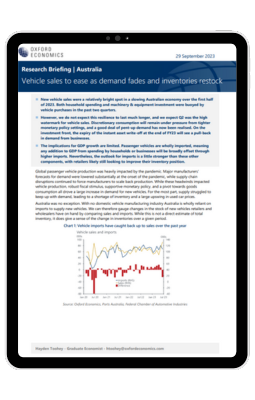Australian asset prices and geopolitical tensions pose key downside risks

The fight against inflation is well underway across the globe, with most central banks either approaching or having already reached the peak of their hiking cycle. Additionally, geo-political tensions and the possibility of increasing restrictions on trade between global rivals remains a key downside risk to the global outlook. Using our Global Economic Model, we consider three alternative scenarios that aim to quantify these risks.
This research report expands on the following points:
- In our first scenario, tensions between China and Taiwan rise significantly in Q1 2024. Whilst we assume a major military escalation and outright conflict are avoided, significant decoupling of trade and technology ensues.
- Our second scenario considers outcomes whereby core inflation slows less sharply than expected in the near term, prompting another round of central bank policy tightening. Banking sector stress flares, with concerns spreading to larger banks, as higher interest rates place pressure of financial and housing market valuations.
- In our third scenario, consumers across advanced economies follow the recent example of the US and run down a significant proportion of the real savings accumulated during the pandemic.
Tags:
Related Services

Post
The socio-economic impact of TikTok in Australia
This report provides the results of our economic modelling of TikTok’s economic contribution to the Australian economy, as well as the findings of survey research into TikTok’s users and Australian businesses. It looks at the real world impacts users report as well as the diversity of TikTok’s online communities.
Find Out More
Post
Australian office sustainability outcomes underpin asset performance
The focus on green office buildings and sustainability is being driven by both government targets to achieve net zero and increasing corporate and investor focus on environmental, social, and corporate governance (ESG) considerations and compliance.
Find Out More
Post
Indian and Australian cities to outpace rivals over 2024-28
We forecast Indian cities to outpace the rest of APAC in terms of GDP growth over the medium term (2024-28). Southeast Asian cities such as Ho Chi Minh City and Jakarta will come close to matching Indian cities and will outperform Chinese ones. Among advanced APAC cities, we expect that Australian ones will fill the top two positions in terms of medium-run GDP growth.
Find Out More